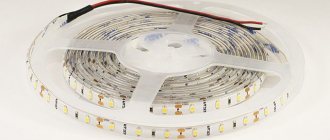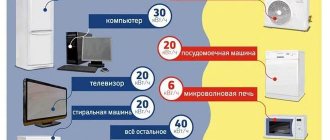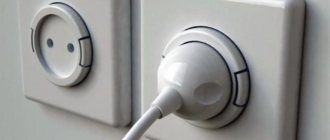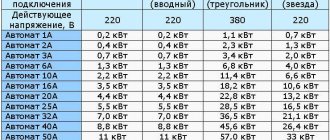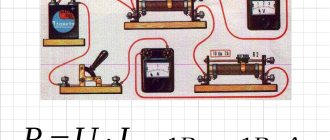Our modern society cannot imagine its life without electricity. It is firmly rooted in the daily and industrial life of a person in the twenty-first century.
Electricity is used not only to illuminate streets, residential buildings and other premises. Today, electricity is needed to power the telephone, computer, TV and many other household appliances in our homes, which make the life of a modern person much easier.
Many home owners use electricity for heating, although this is not the cheapest type of heating, it is quite reliable and easy to use.
Like people in the past, modern society cannot exist without electricity. Every year, scientists are developing new technologies that require power. Of course, today electric current is used more widely than before. But after several decades, its consumption will increase several times. So, for example, if 10 years ago 1.5 - 2 kW of electricity was enough for a house or apartment, today this figure has increased to 15 kW, almost 10 times.
Let's try to figure out how many kilowatts a home currently needs.
Electricity consumers in the house
Decree of the Government of the Russian Federation No. 334 “On improving the procedure for technical connection of consumers to electrical networks” dated April 21, 2009 states that a private individual can connect up to 15 kW to his home. Based on this figure, we will make a calculation to determine how many kilowatts will be enough for our home. To carry out the calculation, you need to know how much electricity each electrical appliance in the house consumes.
Power table of household electrical appliances
The power table for household electrical appliances shows approximate electricity consumption figures. Energy consumption depends on the power of the devices and the frequency of their use.
| Electrical appliance | Power consumption, W |
| Appliances | |
| Electric kettle | 900-2200 |
| Coffee machine | 1000-1200 |
| Toaster | 700-1500 |
| Dishwasher | 1800–2750 |
| Electric stove | 1900–4500 |
| Microwave | 800–1200 |
| Electric meat grinder | 700–1500 |
| Fridge | 300–800 |
| Radio | 20–50 |
| TV | 70–350 |
| Music Center | 200–500 |
| Computer | 300–600 |
| Oven | 1100–2500 |
| Electric lamp | 10–150 |
| Iron | 700–1700 |
| Air purifier | 50–300 |
| Heaters | 1000–2500 |
| Vacuum cleaner | 500–2100 |
| Boiler | 1100–2000 |
| Instantaneous water heater | 4000–6500 |
| Hairdryer | 500–2100 |
| Washing machine | 1800–2700 |
| Air conditioner | 1400–3100 |
| Fan | 20–200 |
| Power tools | |
| Drill | 500–1800 |
| Hammer | 700–2200 |
| Circular saw | 700–1900 |
| Electric planer | 500– 900 |
| Electric jigsaw | 350– 750 |
| Grinding machine | 900–2200 |
| A circular saw | 850–1600 |
Let's do a little calculation based on the data from the table of power consumption of household electrical appliances. For example, in our house there will be a minimum set of electrical appliances: lighting (150 W), refrigerator (500 W), microwave (1000 W), washing machine (2000 W), TV (200 W), computer (500 W), iron (1200 W), vacuum cleaner (1200 W), dishwasher (2000 W). In total, these devices will consume 8750 W, and given the fact that these devices will almost never be turned on at once, the resulting power can be divided in half.
Dedicated power and input machine
In accordance with the value of the allocated power, a corresponding input circuit breaker (or circuit breaker) is installed in the electrical panel, where the external power cable of the electrical network is supplied, which is located immediately after the electric meter.
The device is a box with a switch designed to protect the entire electrical wiring of the house from overload and short circuit currents, as well as a general disconnection of its power supply from the external line. As a rule, after the introductory circuit breaker, additional circuit breakers are installed for various types of loads.
Input circuit breakers can be single-pole, two-pole (used in single-phase electrical networks) and three-pole (used in a three-phase network and allow each phase to be disconnected). For example, with an authorized power of 5.5 kW, a 25 A input circuit breaker (C25) will be installed in the electrical panel. On the Internet you can easily find tables that indicate the permitted power of each circuit breaker model.
How many kilowatts do you need to heat a house?
The main consumers of electric current in homes are lighting, cooking, heating and hot water.
During the cold season, it is important to pay attention to the heating of the house. Electric heating in a house can be of several types:
- water (batteries and boiler);
- purely electric (convector, heated floor);
- combined (warm floor, radiators and boiler).
Let's look at electric heating options and energy consumption.
- Heating using a boiler. If you plan to install an electric boiler, then the choice should fall on a three-phase boiler. The boiler system equally divides the electrical load into phases. Manufacturers produce boilers with different capacities. To choose the right one, you can make a simplified calculation by dividing the area of the house by 10. For example, if the house has an area of 120 m2, then for heating you will need a 12 kW boiler. To save on electricity, you need to install a two-tariff mode for using electricity. Then at night the boiler will operate at an economical rate. Also, in addition to the electric boiler, you need to install a buffer tank, which will accumulate warm water at night and distribute it to heating devices during the day.
- Convector heating. As a rule, convectors are installed under windows and connected directly to an outlet. Their number should correspond to the presence of windows in the room. Experts recommend calculating the total amount for the power consumption of all heating devices and equally distributing it across all three phases. For example, the heating of one floor can be connected to the first one. To another phase, the entire second floor. To the third phase, add a kitchen and a bathroom. Today, convectors have improved functions. This way you can set the desired temperature and choose the heating time. To save money, you can set the time and date of operation of the convector. The device has a “multi-tariff” option, which turns on the heater at the required power or at a reduced rate (after 23-00 and before 8-00). Energy calculations for convectors are similar to the boiler in the previous paragraph.
- Heating using underfloor heating. A very convenient heating option, as you can set the desired temperature for each room. It is not recommended to install heated floors in the place where furniture, refrigerators, and bathrooms are installed. Calculations show that a house of 90 m2 with an installed convector and heated floor on one floor consumes from 5.5 to 9 kW of electricity.
Cost of electricity in the kitchen
If you don't have gas, you'll have to cook with electricity. Modern electric stoves are highly efficient, but they also consume 5 to 7 kilowatts of electricity per hour at full power.
A modern kitchen, even with a powerful stove, does not consume much electricity.
The approximate cost of cooking with electricity will be from 300 to 500 rubles per month, regardless of the size of your home.
How to save energy?
Today there are many options for saving energy. These methods are not at all complicated, but for them to work you need to use them every day. Reducing energy consumption will not only save the family budget, but will also reduce emissions into the environment.
Simple and time-tested saving methods
- Use of energy-saving light bulbs. Such lamps practically do not heat up, so electricity is spent only on lighting. On average, the service life of such lamps is up to 3 years, and this will significantly save costs. Such lamps consume 5 times less electricity, their service life is 10 times longer and pay for themselves in 1 year.
- When using household appliances, it is important to follow the instructions. Let's take the refrigerator for example. It cannot be placed near a stove or radiator, as the device will need to work uninterruptedly to maintain the required temperature. The same applies to the moment when hot food is placed. It is important not to forget to defrost the refrigerator in a timely manner, since ice in the freezer contributes to high energy costs (up to 20%).
- When leaving the room, do not forget to turn off the lights. This advice is the most effective way to save energy.
- Clean light bulbs regularly. At first glance, such advice seems ridiculous. But few people know that dust can block up to 15% of the light. It is important not to forget about the cleanliness of the lampshades. You can use lower wattage lamps.
- Make some minor cosmetic repairs to the room. When choosing wallpaper, you should pay attention to light shades, as they can make the room 80% brighter and more comfortable. We should not forget about the ceiling; it should be made white. This way you will turn on the lights less often.
- Application of heat-reflecting screens. They are made from foil or foam foam. They should be installed behind the battery. Thanks to such screens, the temperature in the room can be raised by several degrees.
- Insulation of the room. It is necessary to insulate the windows or replace them with metal-plastic ones. Up to 30% of heat can be lost through windows. You should hang thick curtains on the windows. If possible, you need to insulate the entrance doors, as well as the walls, ceilings, floors and roofs of the house.
- Purchasing household appliances of class “A”, “A+” and “A++” can save up to 50% of electricity.
- It is not recommended to leave devices in “standby” mode. A person uses any technology for only a few hours during the day. The rest of the time it is in “standby” mode and gradually absorbs electricity. To save money, devices should be turned off from the network.
And so, we already know how many kilowatts are needed for a home. Let's summarize. From what was described above, it follows that if we use electricity sparingly, then we can easily invest in 15 kW, and for a small house this is even enough for heating. Then the whole family will feel comfortable in their cozy nest.
What is the allocated power of electricity and how to increase it
Modern household appliances require electricity to operate, but the number of electrical appliances connected simultaneously is limited by the allocated power. If you have an apartment or property with gas, there is often no need for a large amount of electrical energy.
If there is no gas and you need to increase the limit, you can increase the established rate for your apartment. This can be done by contacting the operating organization. If you do not increase the established electricity rate, you will not be able to achieve the desired comfort in your home.
Next, we will talk about how to find out and increase the allocated electricity capacity for an apartment and a private house.
What it is
During capital construction during the USSR, for example in Khrushchev buildings, i.e. In most of the residential premises that are still in use today, even at the design stage, the allocated power was 1.5 kW per apartment.
Later, the established electricity rate increased to 3 kW, as it became necessary to increase it due to the increased “gluttony” of consumers.
Practice shows that 10-16 Ampere plugs were usually installed in electrical panels and meters, so that the maximum current consumed by an apartment was limited to a total electrical power of 3 kW for apartments with a gas stove. For apartments where an electric stove is installed, 7 kW is allocated.
In new buildings, the allocated power can reach up to 15 kW. This scatter is due to the fact that during the construction of old houses (60s, 70s) there simply were not such powerful consumers and as many household appliances as there are now.
The allocated power is the maximum amount of electricity consumed at one point in time.
In addition, in order to enter the established limit, sometimes you need to enter not just 1 phase, as often happens, but as many as 3 phases.
This is necessary for connecting modern household appliances, such as powerful electric boilers and electric stoves.
This is especially true in commercial premises and industries of any scale, where a lot of electricity is needed (up to 30 kW and above).
Example. To heat a country house that is not equipped with gas equipment, solid fuel and electric boilers are installed, the latter are safer and more convenient.
For heating a house with an area of 100 sq.m. you need a boiler with a power of about 7-10 kW, an electric stove consumes another 3-5 kW.
In total, it is necessary to increase the established electricity limit to a minimum of 15 kW and supply electricity in three phases.
To find out the allocated power for a private house or apartment, you need to contact the operating organization (in Moscow and the region - this is Mosenergosbyt OJSC). The help contains information about the allocated and average power consumption. It will be needed if you are preparing documents for an increase; this will be discussed in detail below.
Private person
The first step is to collect a package of documents. It’s worth starting with obtaining technical specifications and developing an electrical project. A power supply project for an installation is a set of technical documentation made in accordance with GOSTs and state regulations.
It can only be performed by organizations with the required license. And here you will need a floor plan, it can be ordered from design studios, a certificate of the amount of allocated energy, technical specifications, etc.
Certain points can be discussed individually, or the designer will visit the site to familiarize himself with the task.
The next step is coordination of the project with energy supply organizations. Next, the installation is tested and its compliance with the design. If the object does not comply with the project, it is necessary to either bring it into compliance or order a new project according to the actual situation.
After this, an approval certificate is drawn up, this is done by energy supervision employees. At the end, a complete package of documents with all permits is submitted to the energy supply organization and the connection or increase in the allocated power is carried out.
In total, to increase the allocated electrical power, you will need:
- Obtaining technical specifications.
- Development of a power supply project.
- Coordination of the project with the energy supply organization.
- Checking the installation.
- Drawing up an admission certificate.
- Transfer of a package of documents to the ES organization.
- Conclusion of a new agreement.
To draw up an electrical project you need:
- The act of delimiting balance sheet ownership (take it to the DEZ or comrades of home owners).
- Certificate of allocated power.
- A document that confirms ownership of real estate.
- A site plan showing ALL electricity receivers.
Calculation of the total power consumption of the load in the house
Calculation of the total power consumed by the load is necessary to find out whether there will be enough power to supply existing electrical appliances with electricity and connect new consumers in the future.
The power consumed by the entire load is calculated as the sum of the power consumption of all devices turned on at the same time. To do this, you need to find out the maximum active power of each consumer, taking into account its starting currents. It is indicated on the “nameplate” or in the data sheet of the device and is measured in W.
You can also find the designation of power consumption in volt-amperes (VA). But this is not the same meaning. Active power is measured in watts (denoted by the letter “P”), and in volt-amperes - total power (denoted by the letter “S”). To calculate the maximum load, you will need exactly the value in W. To convert VA to W, you need to use an online calculator or the formula: P = S x cos(φ), where cos(φ) is the power factor (if it is unknown, then the average value is usually taken, which is equal to 0.8).
